Hoi An in Vietnam is a must-see. We spent two weeks in this city and enjoyed it to the fullest. Hoi An is one of the most popular cities in the entire country. So, it wasn’t surprising that there were so many tourists around during the day. The city is beautiful with all its colorful lanterns, charming alleys, cafes, boutiques, and fantastic tailoring shops. In the following article, we’ll take you through Hoi An in Vietnam and reveal our best tips, sights, and information for your trip.
You might also be interested in:
- Entry and Visa for Vietnam
- Best time to travel to Vietnam
- All about Saigon in Vietnam
- The best travel tips for Thailand
- The best travel tips for Malaysia
- Information and highlights in Indonesia
- Adventurous Hong Kong
- Travel tips & Highlights in Singapore
- You might also be interested in:
- General information about Hoi An
- Hoi An in Vietnam – Arrival
- Getting from A to B on site
- Our accommodation
- Day pass for the old town
- Sights in Hoi An
- The beautiful old town
- Old town at night
- The Japanese Bridge
- Chinese assembly halls
- Old Houses Hoi An
- Museums in Hoi An
- Central Market in Hoi An
- Hoi An in Vietnam – Tours & Excursions
- By bike
- My Son Temple Town
- Tra Que Herb Village
- Hai Van Cloud Pass
- Beach & Islands
- Restaurants & Cafés
- Shopping & Tailoring
- Our conclusion about Hoi An
General information about Hoi An
Hoi An is located in central Vietnam on the coast of the South China Sea. With around 75,000 inhabitants, the city is not that small, but compared to other cities, it is not too large either. Da Nang is only 30 km from Hoi An (airport). Hoi An, Vietnam, used to be the largest port in Southeast Asia, which can also be explained by its location on the Silk Road.
Hoi An has a beautiful old town, which is the only one that remained unscathed during the Vietnam War. In 1999, this old town was even declared a UNESCO World Heritage Site. But don’t be surprised by the many tourists. During the day, Hoi An is really crowded and bustling. It’s much more pleasant early in the morning and late in the evening.
Hoi An in Vietnam – Arrival
We flew from Hong Kong to Da Nang (Entry and Visa Vietnam). However, you can also arrive from many other airports. If you’re already in Vietnam, you can fly from Ho Chi Minh or Hanoi to Da Nang. You can also travel by bus/train, as there are numerous bus connections to the north from Ho Chi Minh City. The bus stops at various locations along the way. According to the website Rome2Rio, the bus ride takes around 23 hours, as buses usually cannot travel faster than 50-60 km/h.

According to other backpackers, traveling by train is also very popular in Vietnam. We did some research and found that there are trains with different classes, as well as trains with sleeping compartments. The train from Ho Chi Minh City takes around 17 hours to Hoi An/Da Nang. However, train tickets are much more expensive than bus tickets. It is usually cheaper to fly to Da Nang (VietJet and JetAirways). Bus or train are, of course, more environmentally friendly.
From Hanoi, you can also travel to Da Nang/Hoi An by bus or train. You should plan on about 16 hours for the bus ride and around 15 hours by train. From Hue, it’s about 120 kilometers, which you can cover by taxi or minibus. The minibus ride costs around 200,000 dong (€7.64). You can find excellent information on this topic here: www.zugreiseblog.de.
Tip: We read in the Tripadvisor forum that there is an official bus from Da Nang to Hoi An. The ride takes around an hour and shouldn’t cost more than 75,000 dong (€2.50). We took a taxi from Da Nang to Hoi An, which cost around 300.00 dong (€11.40).
Getting from A to B on site
Hoi An is essentially a fairly small town, which you can easily explore on foot, especially in the center. Otherwise, the number one means of transportation is scooters and bicycles. We were always able to borrow bikes for free from our accommodations. This meant we could always cycle into town or to the sea in a relaxed manner. Get used to the noise in the city. People honk like crazy here. In Vietnam, people honk even from 3 km away. If you’re not used to it, you’ll quickly lose patience.
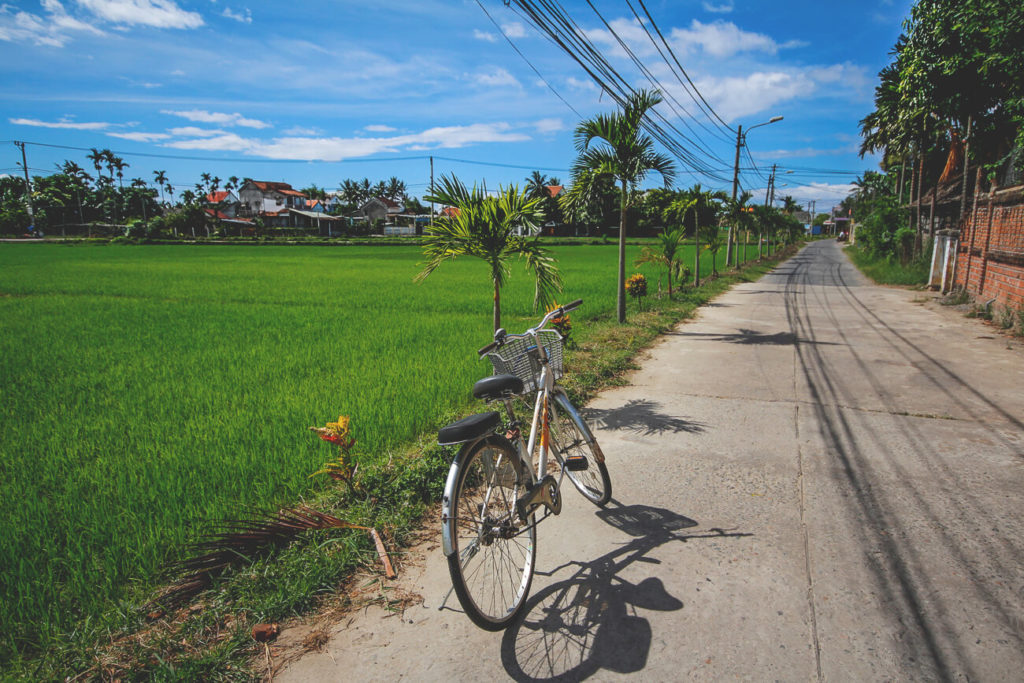
If your accommodation doesn’t offer bicycles, you can find several providers in the city (e.g., Vietnam Bike Tours or Hoi An Bike Rental). Alternatively, you can also travel within the city with so-called tuk-tuks and bicycle rickshaws. You can hail these simply by hailing them. These drivers can be found along the roadside practically everywhere in the city. You should find a suitable driver relatively quickly.
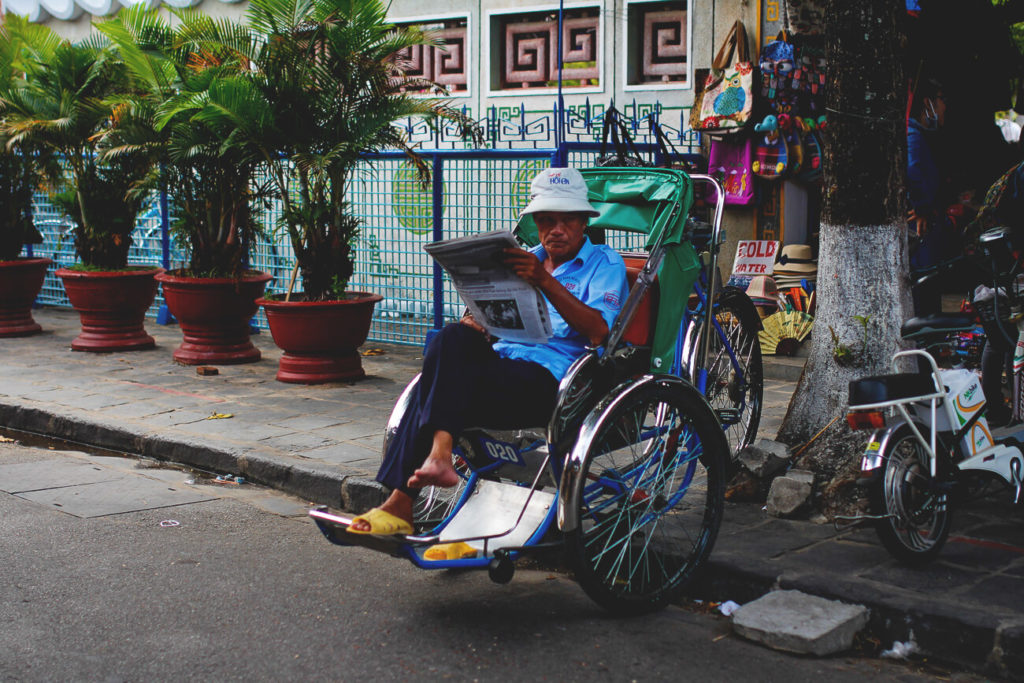
Our Accommodation
In Vietnam, you get a lot for your money. You can get beautiful double rooms for as little as €9 per night, and top 4-star hotels for only €20 including breakfast. Our first accommodation was the Lemongrass Homestay* (now called Gita Boutique Villas) in the rice fields. We really liked this family-run homestay. We had a large, modern room with a bathroom and Wi-Fi. We were even allowed to use the beautiful pool at the neighboring hotel.

You get a free bicycle and a delicious breakfast in the morning with plenty of fruit, pancakes, bread, and eggs. The historic old town is only about 3 kilometers away. The rooms are decorated in an Asian style and are air-conditioned. We had a contact person around the clock, and the service was truly top-notch. Back then, we only had to pay €15 per night for the two of us, including breakfast and bikes. Crazy, right? Today it’s around €20-25 per night. Update 05/2020: The homestay is now called “Cat Tuong Boutique Villas” and has been renovated.

More accommodations in Hoi An:
- Bougain Villeas Homestay*
- Chi Thanh Villa*
- Hoi An Merrily Homestay*
- Hoianation Villas Hotel*
- Relax Garden Boutique Villa Hoi An*
- Hoi An Osaka Boutique Villa*
- Cozy Savvy Boutique Hotel Hoi An*
Old Town Day Pass
For Hoi Old Town On you need a day pass. This allows you to see the individual sights and stroll through the old town. You can purchase the Sightseeing Ticket at various local offices. According to the “Hidden Hoi An” website, the ticket costs 120,000 dong (€4.30). As soon as you arrive at a sight, a strip of the ticket is removed until none remains. If you buy the ticket, it is valid for 10 days. While we were in Hoi An, we didn’t know anything about this ticket and didn’t have to buy one. Today, however, it seems to be much more strictly enforced and controlled. More information here: Hoi An Old Town Ticket*.
Sights in Hoi An
Now let’s move on to the sights worth seeing in and around Hoi An in Vietnam. The small town has a lot to offer. We enjoyed exploring, especially in the early morning, and brought home some beautiful pictures. Hoi An is extremely photogenic. We’ve marked a few spots for you on the map:
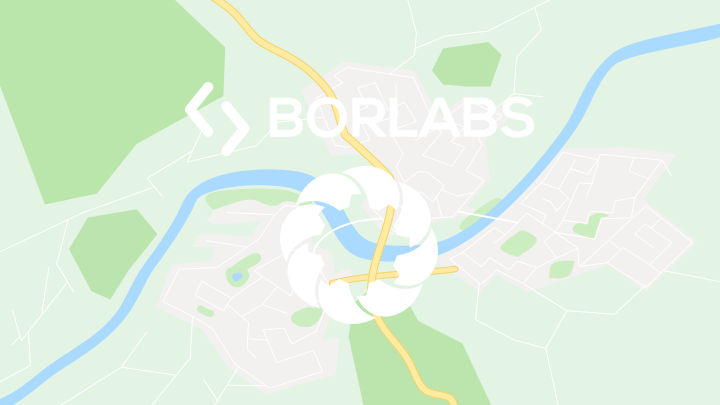
By loading the map, you accept Google’s privacy policy.
Learn more
Load map
The beautiful old town
One of the absolute highlights in Hoi An is the old town itself. It is one of the most beautiful in the entire country. It’s incredibly fun to stroll through the alleys and explore the area. The old town is even closed to motorcycles and scooters between 8:30 and 11 a.m. and between 3 p.m. and 9 p.m., so you can stroll through the alleys quite relaxed.
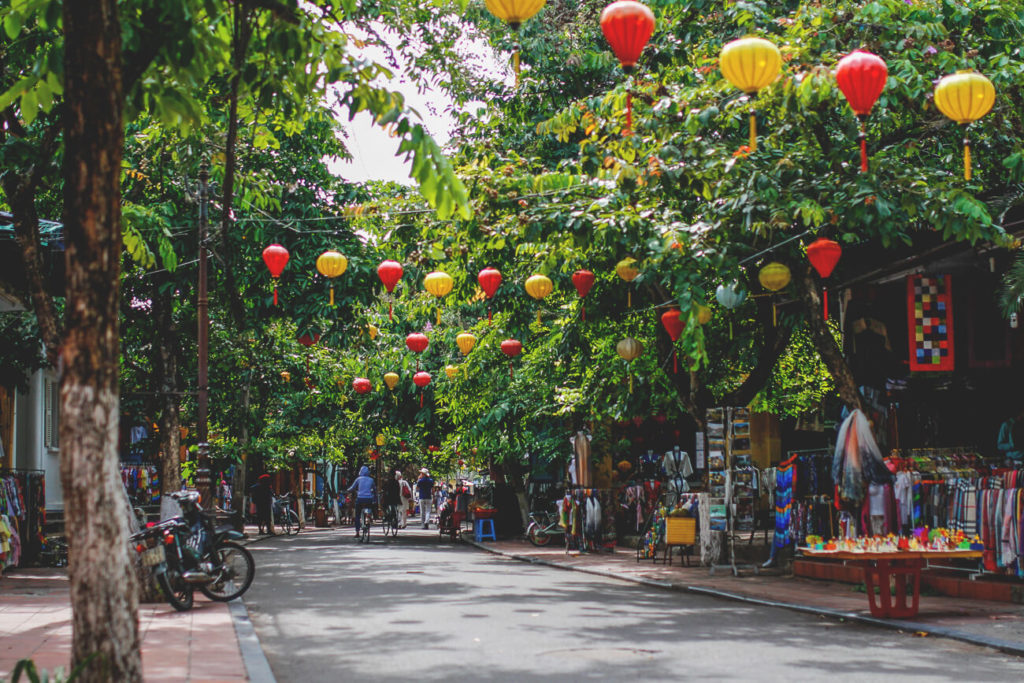
In the Old Town, you can simply let yourself go. There are so many alleys, shops, cafés, restaurants, and historic buildings. The colorful lanterns hanging everywhere on the houses and above the streets are particularly beautiful. In the evening, the colors are particularly beautiful, but also particularly crowded. Hoi An is very popular and very touristy. We want to emphasize this at this point, although a visit is absolutely recommended nonetheless.
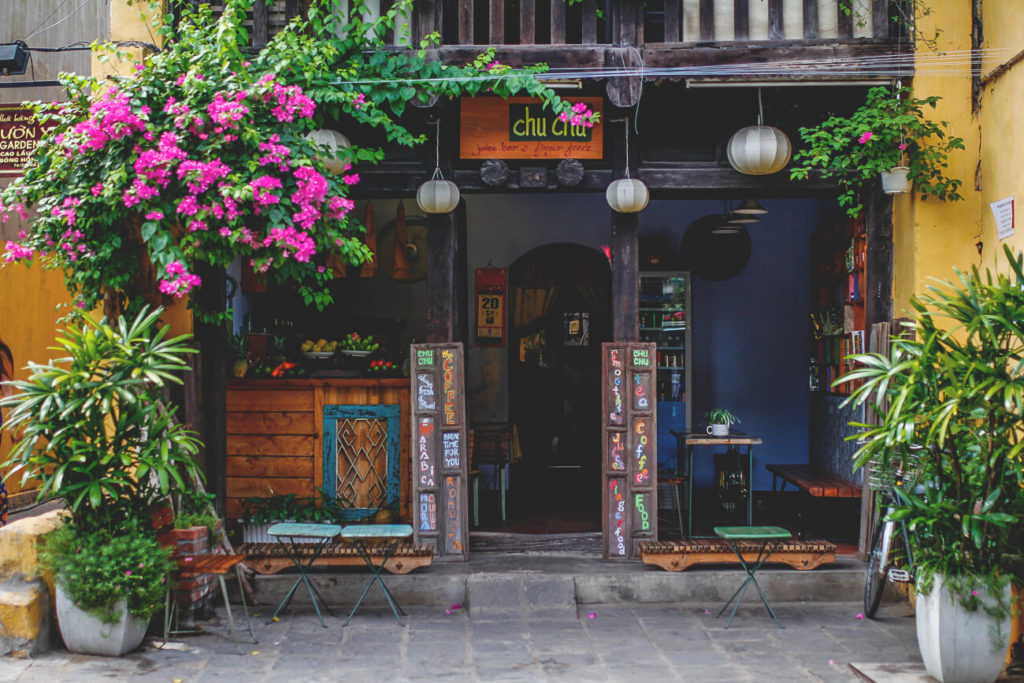
Old Town in the evening
In the evening, the old town transforms into a promenade with colorful lanterns and lights. In the early evening, there is a lot going on here. You can hang out in one of the many bars or enjoy a delicious meal in one of the many restaurants. Of course, it is more expensive than outside the old town. But there are also many food stalls where you can eat really cheaply. One stall next to the other, it’s quite bustling and loud.

The later the evening, the fewer tourists there are on the streets. You can get a beer and sit by the river. At the night market, you can get just about anything: clothing, decorative items, jewelry, souvenirs, and food. Of course, it’s all geared towards tourists and has nothing to do with a “local market.” But it’s best to experience it for yourself and see for yourself.
The Japanese Bridge
The landmark of Hoi An is clearly the Japanese Bridge. At that time, we didn’t know about a day ticket for the Old Town and wanted to walk across the bridge before we were stopped. Without a ticket, we weren’t allowed to walk across the bridge. It was built in 1590 and is a beautiful example of traditional Japanese architecture. We weren’t that impressed by this bridge. But since you’ll pass by it sooner or later anyway, it’s a good idea to take a quick look.
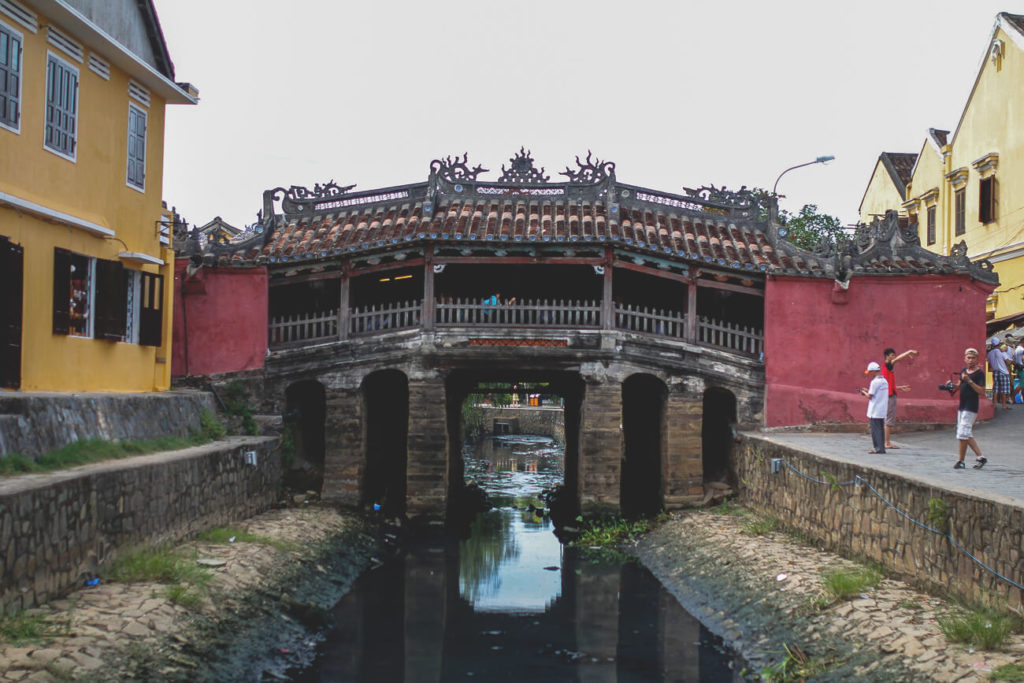
Chinese Assembly Halls
In Hoi An, there are still 4 Chinese Assembly Halls to see, as the city used to be primarily inhabited by Chinese people. The following halls are located: Fujian, Trieu Chau, Hai Nam, and Quang Trieu. We stumbled upon Trieu Chau by chance. It’s a very beautiful assembly hall with many charming details, statues, and decorations. The halls are open Monday to Sunday from 7 a.m. to 9 p.m.
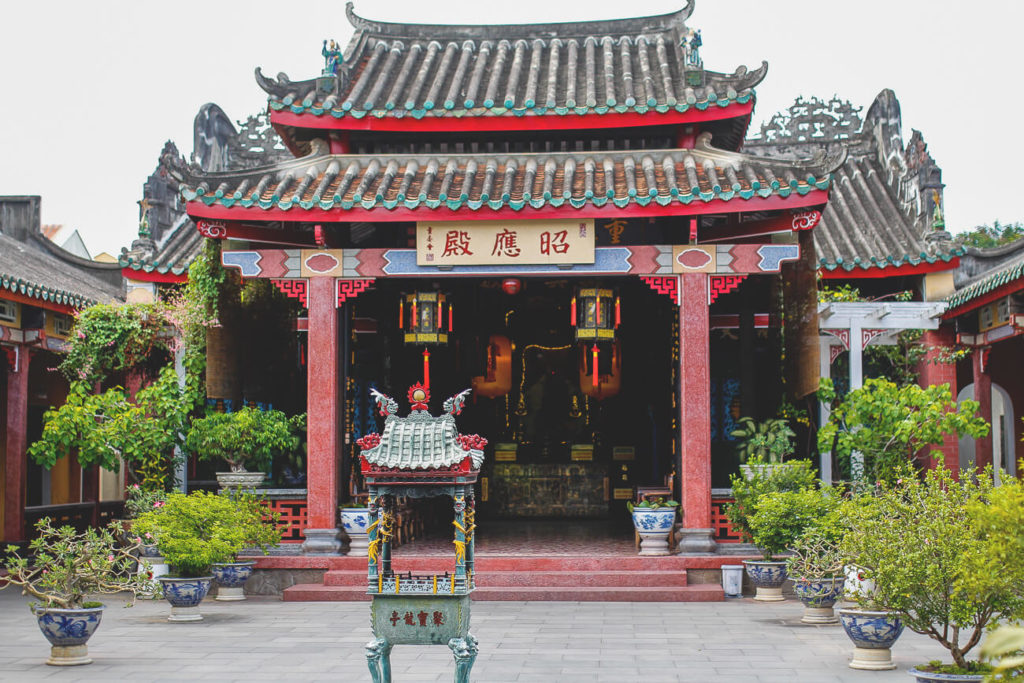
Old Houses in Hoi An
There are still a few “old houses” in Hoi An. These are open to the public and showcase the lives of the families. For example, there is the Trần Family’s Chapel, the Old House of Đức An, the Nguyễn Tường Family’s Chapel, the Old House of Phùng Hưng, the Old House of Quân Thắng and the Old House of Tấn Ký. Here you can marvel at truly beautiful courtyards and interiors.
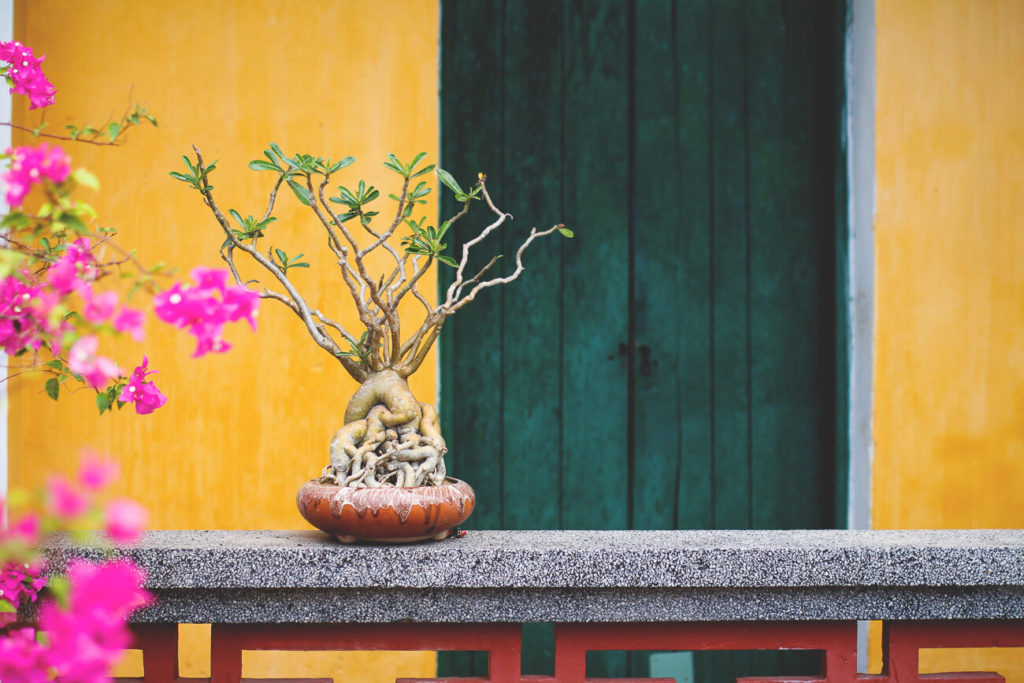
Museums in Hoi An
In the Old Town of Hoi An, you’ll also find several museums. For example, you can take a tour of the Folk Culture Museum, the Sa Huynh Culture Museum, or the Trade Ceramics of Hoi An Museum. We’re often ignorant of museums, and the same goes for Hoi An. We haven’t been to any of the museums, so we can’t give you any more detailed information. But you’re sure to find plenty of information online.
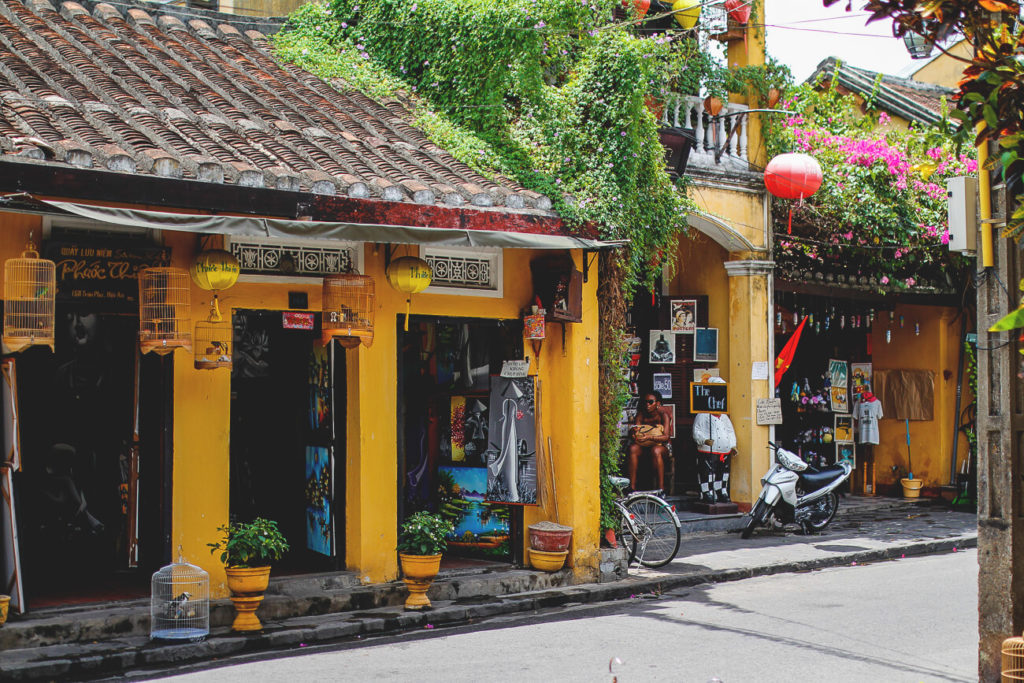
Central Market in Hoi An
During the day, the Central Market takes place in Hoi An. Here you can find fruit and vegetables in all shapes and sizes. The food hall offers culinary highlights you shouldn’t miss. The market opens around 6 a.m. and that’s when it’s busiest. The locals naturally arrive as early as possible, before the tourists crawl out of their dens. So, if you arrive early, you can still experience the “real hustle and bustle” of Hoi An.
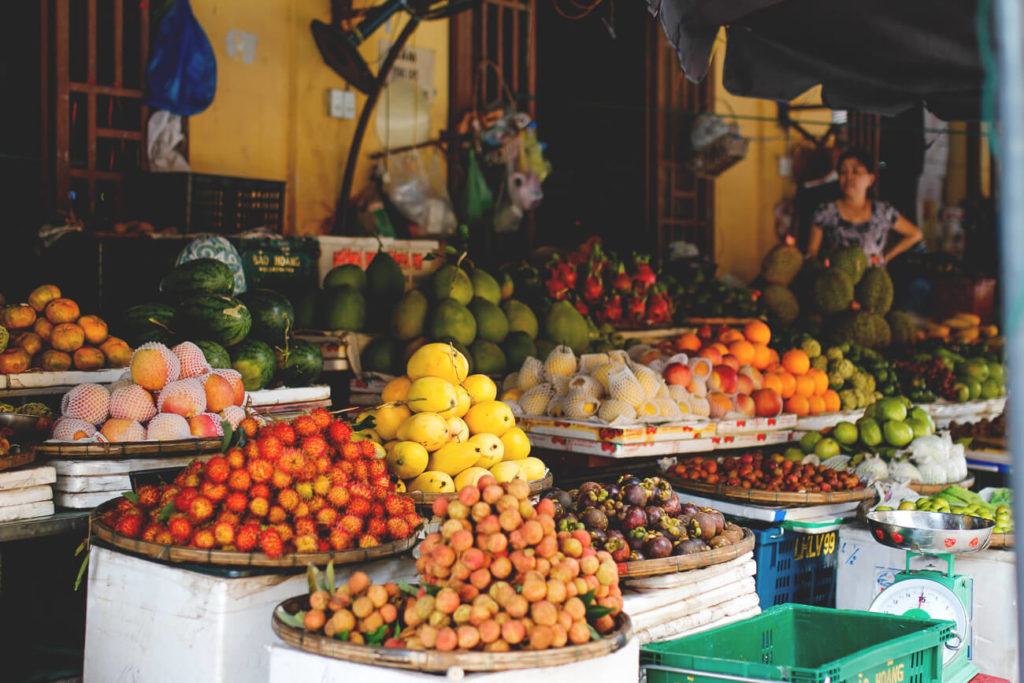
Every evening from 6 p.m., the night market starts in the Old Town, as described above. Hoi An also has a textile market with an incredible abundance of textiles. Here, you can find absolutely anything you can imagine. And always remember: Don’t forget to bargain!
Hoi An in Vietnam – Tours & Excursions
There’s not only a lot to see in Hoi An, but also some highlights in the surrounding area. In the following section, we’ll introduce you to the most important excursion destinations and tours in more detail. Have fun browsing!
By bike
We spent most of our time on our bikes. Since our accommodation was right in the rice fields, we were able to cycle directly from there to the sea. It’s so much fun to leisurely stroll through the countryside. Along the way, you’ll repeatedly see Vietnamese fieldworkers with their buffaloes, so typical of Vietnam. Just go with the flow and see where you end up.
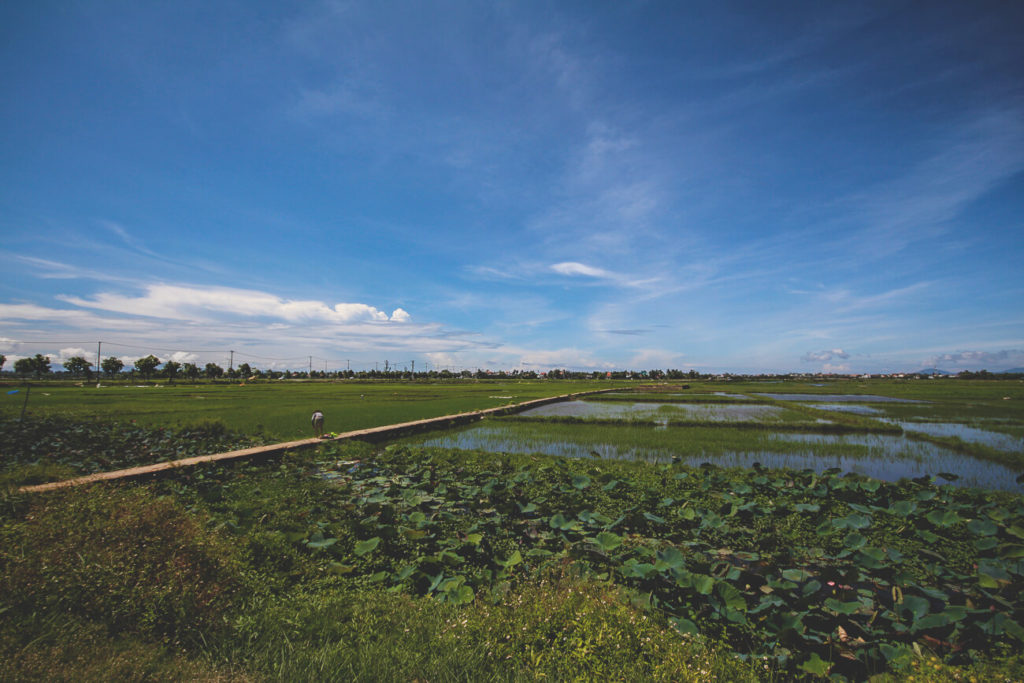
My Son Temple Town
Just under 40 kilometers from Hoi An is the temple town of My Son. More than 70 temples are still preserved. In 1999, My Son was declared a World Heritage Site, along with the old town. It’s best to book a taxi (using the UBER app) to get to the temple complex. Alternatively, you can also book a guided tour (from €10). The complex is open daily between 6:30 a.m. and 5 p.m. It’s best to arrive as early as possible. It gets crowded after 10 a.m.! Admission costs 150,000 dong (€5.73).

Tra Que Herb Village
Just 4 kilometers from the old town lies Tra Que Herb Village. This village is truly a paradise! The non-profit farm provides locals with a piece of land free of charge. However, they must then farm it organically. They grow fruit, vegetables, and herbs here.
You can book interesting tours where you first shop for ingredients at the market, then help with field work in the Herb Village, and finally learn how to prepare Vietnamese dishes in a cooking class. Tours start at €69 per person*.
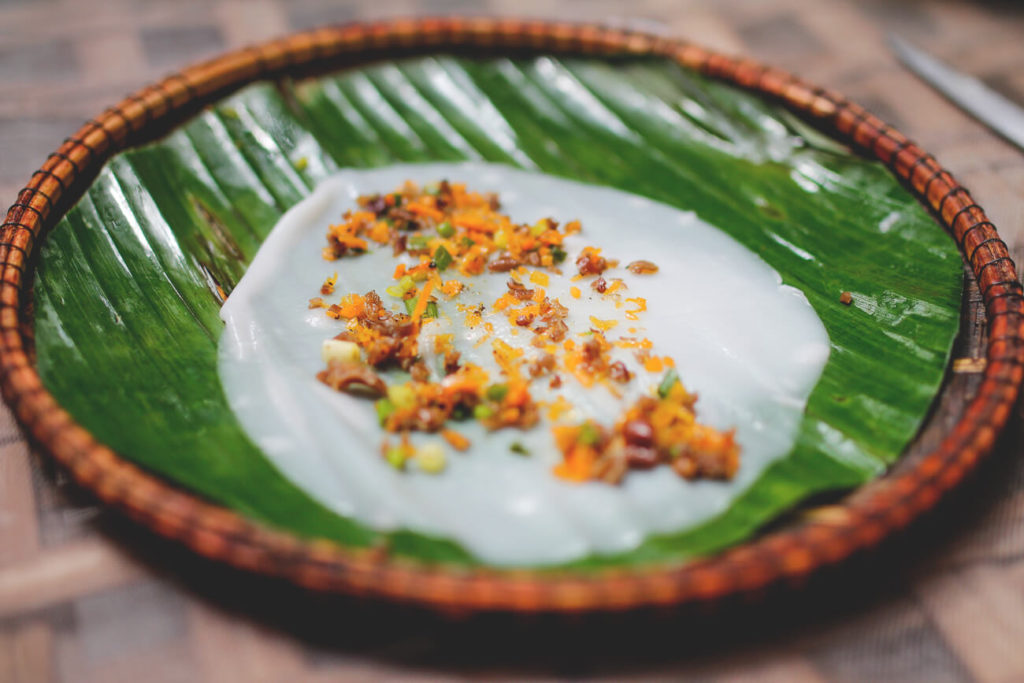
Hai Van Cloud Pass
The legendary Hai Van Cloud Pass is located about 56 kilometers north of Hoi An. This approximately 20-kilometer-long pass runs between Hue and Da Nang and forms the border between the north and south of the country. The landscapes are magnificent and offer fantastic views. As you pass the pass, you can see the South China Sea on the other side of the mountains. Since the Hai Van Tunnel has been open since 2005, it is quite quiet on the pass.
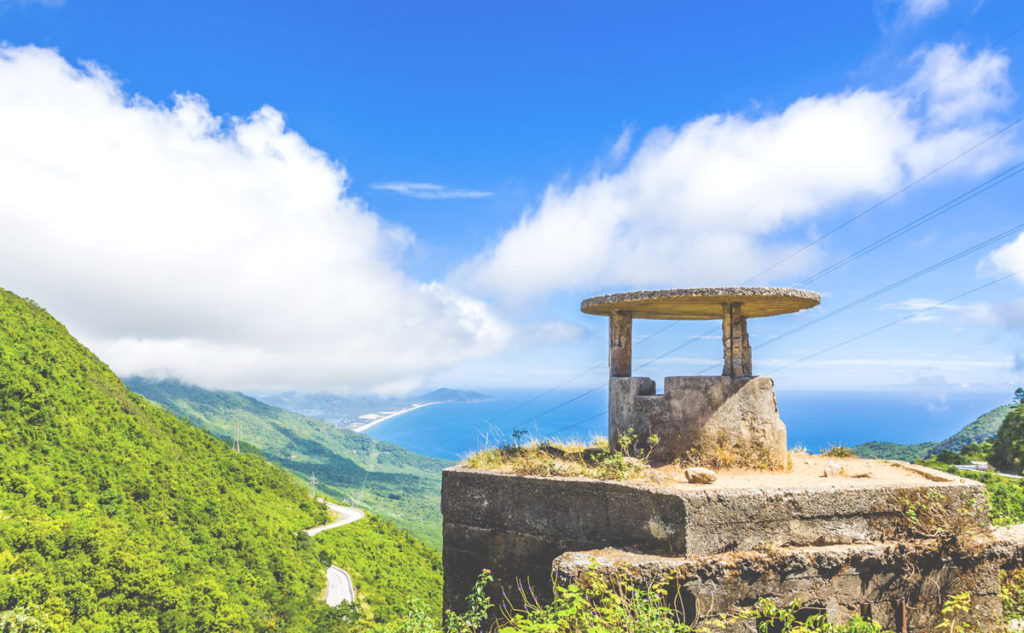
Beach & Islands
From our accommodation, it was only a 5-kilometer bike ride to the beautiful An Bang Beach. This is a truly beautiful beach on the South China Sea. The sand is soft and light, and the sea is turquoise blue. We were able to lie on the beach in perfect weather and let the sun shine on our stomachs. We repeatedly saw fishermen in their traditional boats. You’ll also find small beach cafes and restaurants there. Many will charge you a few euros to park your bike.
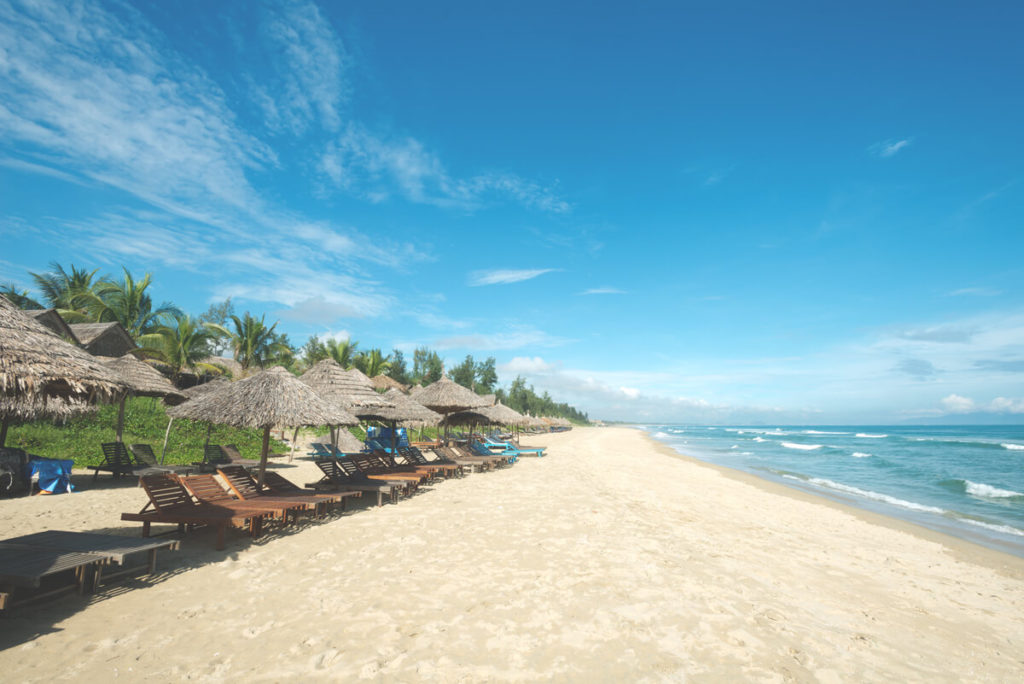
Off this coast are the so-called Cham Islands. You can book numerous tours to the islands. From the mainland, it’s only about 15 km by boat. Tours are available at any tour office starting at 600,000 dong. The speedboat then takes you over to the largest village of the Cham Islands in 25 minutes. There are a few buildings there for you to look at. Afterward, it’s on to snorkeling and the beaches. We didn’t do any of these tours, so we can’t give you any specific information.
Restaurants & Cafés
In Hoi An, you’ll find countless cafés, restaurants, and fast food outlets. We couldn’t get enough of the cuisine. Especially because it’s so incredibly cheap, we went out to eat several times a day. We preferred to eat in smaller restaurants outside the old town.
On the one hand, it wasn’t as busy there, and on the other hand, it was of course cheaper. We spent a lot of time in the cafés in the old town. There, we worked on our laptops and sipped delicious coffee. We can recommend the Hoi An Roastery, the Phin Coffee, and the Reaching Out Teahouse. These cafés are usually very cool and cozy.

You’ll discover many others, especially in the Old Town. We devoured incredibly delicious burgers at the Circle Café. We stumbled upon them by chance while out cycling. Everything is prepared fresh and crispy. At the Nu Eatery, you’ll find a wide selection of local and international dishes. At the small, family-run snack bar Quan Dau Bac, you can get authentic Vietnamese food.
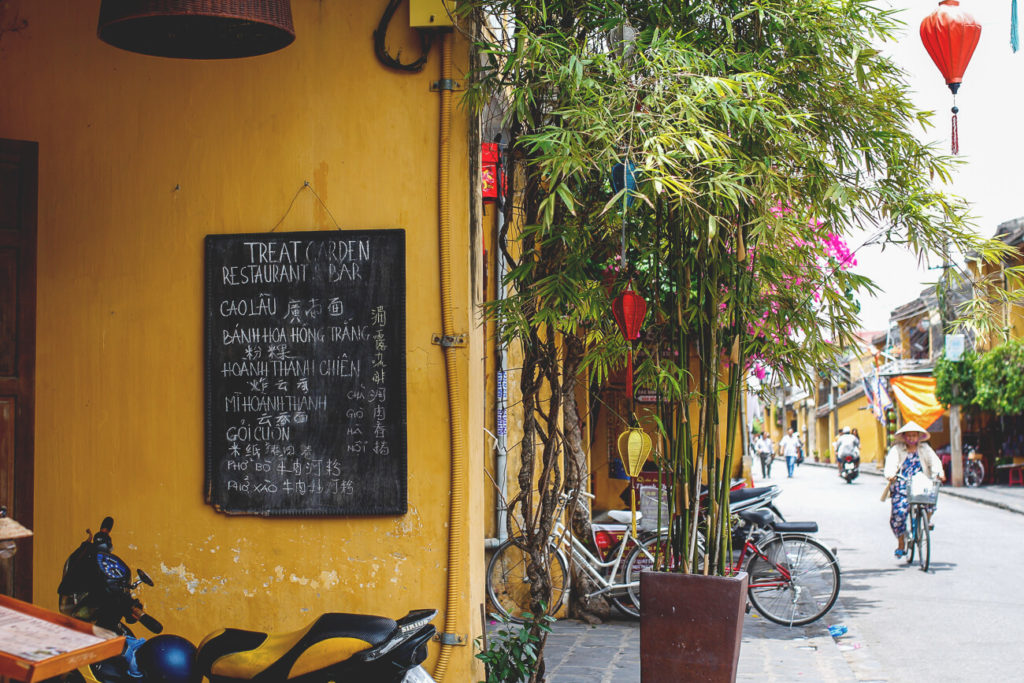
Shopping & Tailors
You can really spend a lot of money in Hoi An. That’s because there are so many cool shops and stores. Incidentally, Hoi An is also called the “City of Tailors”. Here in Hoi An, one shop follows the next, each one wanting to sew your new clothes. So be prepared to be approached in front of every shop.
And we took advantage of this, too. My sister’s wedding was coming up soon, so we had ourselves dressed from head to toe. We were approached by countless people on the street. In the end, we went to the shop we liked the most.

The service was excellent, and the end result was even better. Marco got trousers, a shirt, and a jacket. I got a dress that was tailored exactly to my needs. You can tell me exactly how you want your garment to look; they really make anything possible. You can even have shoes, belts, bags, or accessories made. After two days, we were able to pick up everything ready-made – simply brilliant. Unfortunately, we didn’t remember the name of this shop.
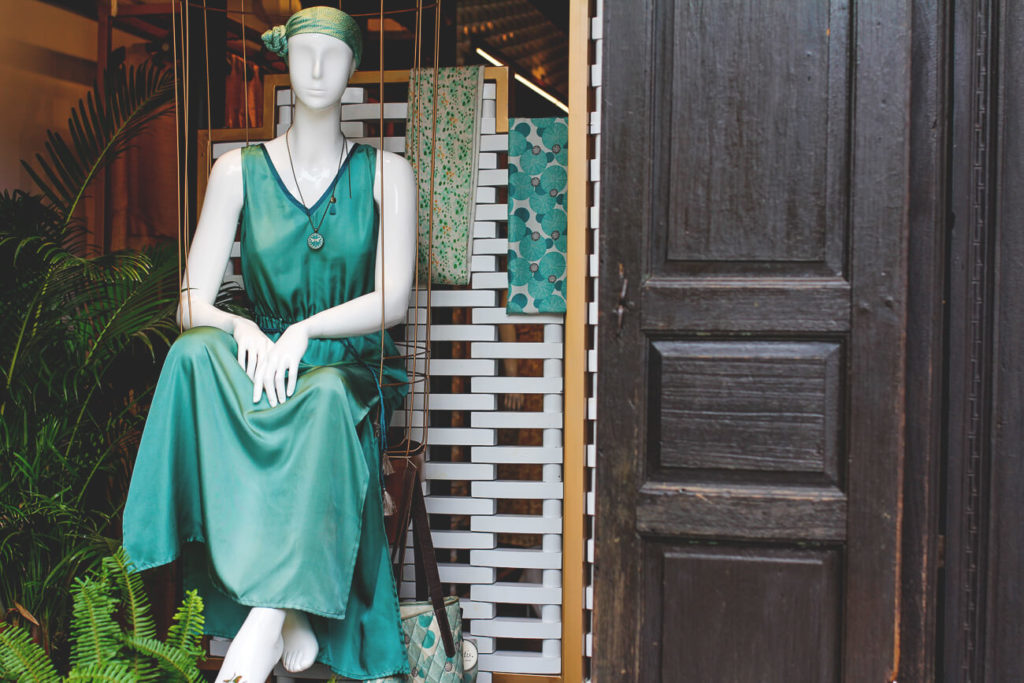
In the Old Town, you’ll also find many souvenir shops and boutiques. You can find practically anything you can imagine here. Just go with the flow and browse the shops. According to TripAdvisor, the tailors The Tailor, Ba Ri Tailor, Peace Tailor, and Bao Diep Tailor are popular. It’s best to see for yourself what the shops have to offer. And we’re not exaggerating when we say that there seem to be 1,000 tailors in Hoi An.
Our conclusion about Hoi An
We had a fantastic time in Hoi An. During the day, the alleys of the Old Town are incredibly crowded. It’s much more pleasant only in the early morning and late evening. We spent most of the day on our laptops, by the pool, in the rice fields, or in the café. You shouldn’t go sightseeing during rush hour.
Hoi An is charming, incredibly beautiful, and even cozy. You get a lot for your money here. There’s a lot to discover in the surrounding area, and the beaches are also very beautiful. For us, Hoi An is a great all-round package. Just be aware that you have to expect really big crowds during the day. Large Asian tour groups, in particular, push their way from highlight to highlight.
We recommend at least 5 days for your trip to Hoi An. This way, you can explore the old town and also take excursions in the surrounding area. Since we didn’t spend much time in Vietnam, we have no comparisons to other places. There are certainly countless other regions in Vietnam where things might not be quite as touristy as Hoi An. We still liked it!